A Private Tour today, on the North Norfolk coast. It was a lovely sunny start to the day and, although it clouded over later in the morning, it rather helpfully remained dry until just as we finished this afternoon.
Our first stop this morning was at Holkham. As we drove into Lady Anne’s Drive, we spotted a Grey Partridge out on one of the fields. As we pulled up, it started to chase after a second bird which was further back, nearer the hedge. Two more Grey Partridge were watching nearby and it seemed like a territorial dispute was underway between two pairs.
The two Grey Partridges chasing each other were males and eventually one ran over towards the road, collecting one of the females on its way past, before ducking under the gate and coming out onto the verge. We had a great view of the two of them here, from the car, as the female fed and the male stood nearby, keeping watch.
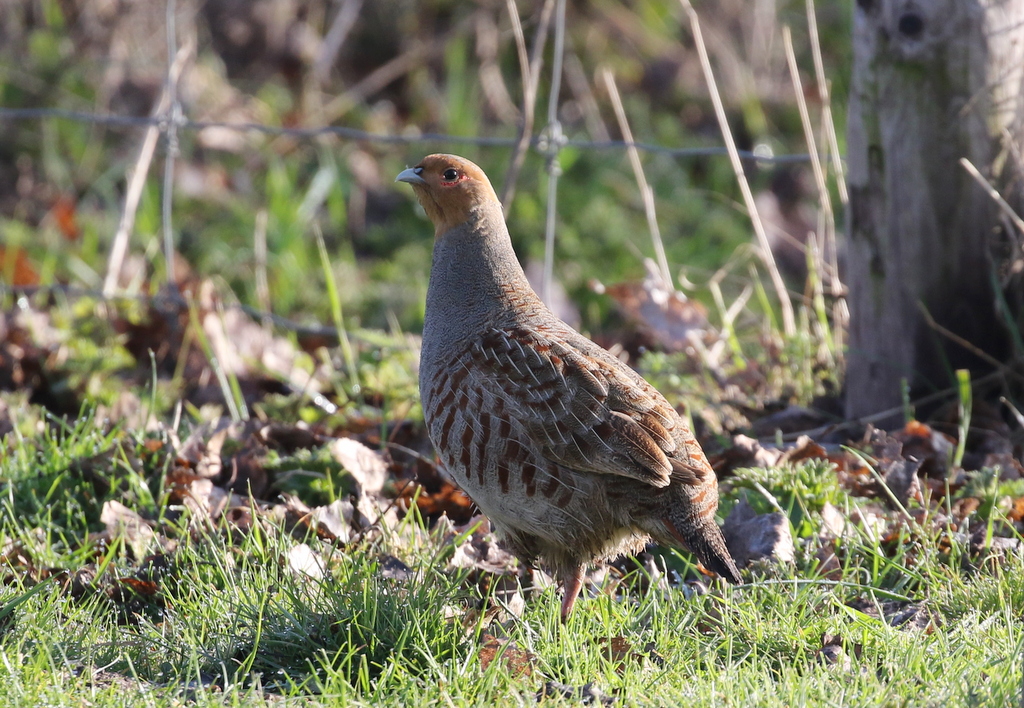
We hadn’t got much further when we caught a quick glimpse of a Barn Owl flying up over a line of reeds beside the road. We pulled up just beyond the reeds and there was the Barn Owl down in the short grass. We got out quietly and watched as it appeared to pick at something at its feet. We couldn’t see whether it had caught anything, but when it eventually flew up its talons were empty.
It flew back over the line of reeds and we walked back to find the Barn Owl now on a post the other side. It was staring intently down into the grass below, occasionally looking round or up to make sure it was not about to be mobbed or attacked.
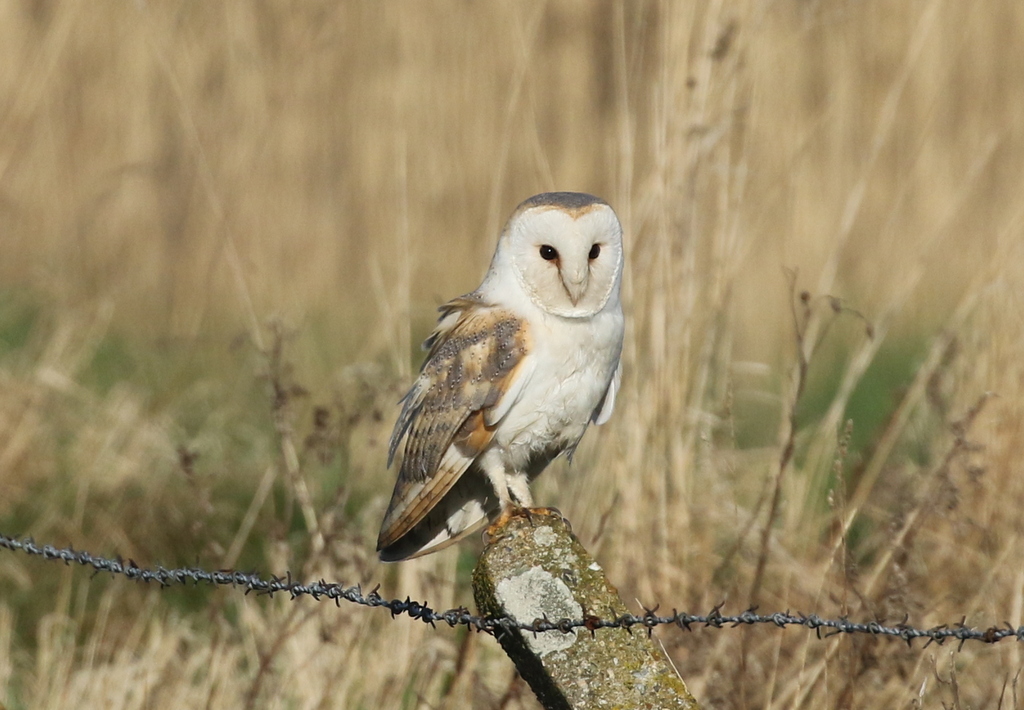
Periodically, the Barn Owl would fly along to the next post and start looking down at the ground again. Once or twice it took off and dived sharply down into the long grass, but once again we didn’t actually see it catch anything.

It gradually worked its way towards us along the fence line, until it got to a large bush which blocked its progress. Then the Barn Owl took off and flew straight at us, passing by just a few metres in front of us before landing on one of the posts back along the edge of Lady Anne’s Drive. Stunning views!
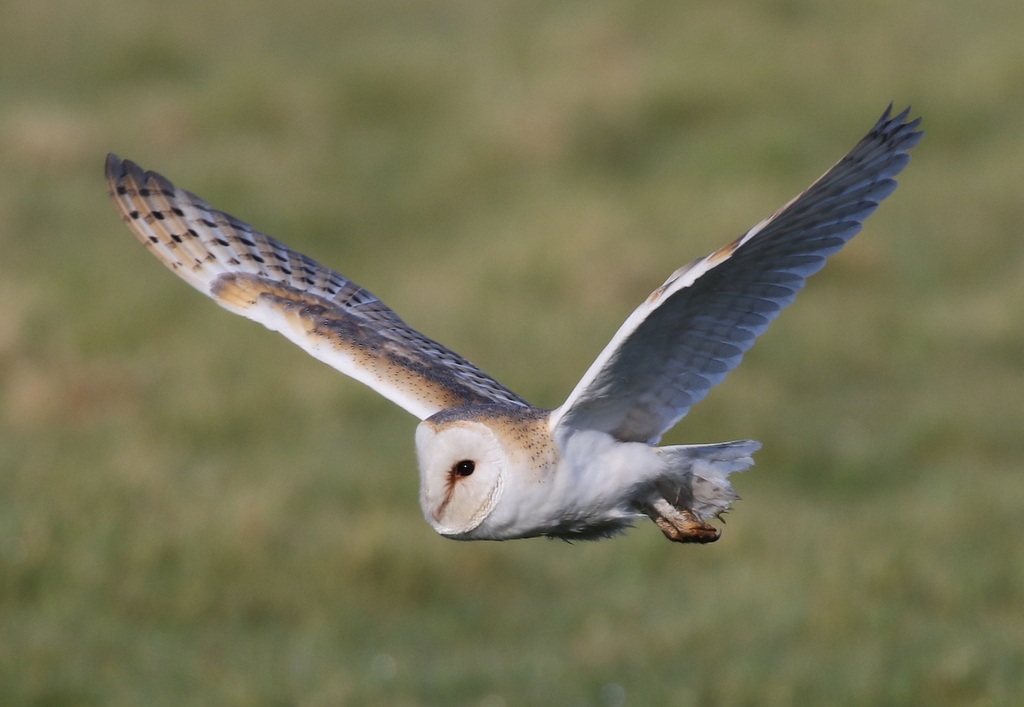
We left the Barn Owl in peace to carry on hunting and walked a little further up Lady Anne’s Drive to have a look on the pools. Several Teal and Shoveler were asleep in the rushes along the edge and there were a few Greylag and Egyptian Geese here too. But there were no Wigeon along here today – there appears to have been a big clear out over the last week, as birds have departed on their way back to their breeding grounds for the summer.
There were a few waders too. A scattering of Curlew, Redshank and Lapwing were feeding on the mud, as were a pair of Oystercatcher and a couple of Common Snipe zipped across before dropping down into the vegetation out of view. A Little Egret was good to see as numbers along the coast appear to have declined after the recent snow. A couple of Marsh Harriers circled up over the back and a very pale Common Buzzard perched on a bush out in the middle of the grazing marsh.
As we walked back to the car, we could see the Barn Owl had returned to the posts out in the middle, where it had been earlier. We eventually tore ourselves away and carried on to the end of Lady Anne’s Drive, where we parked. The Shorelarks have not been reported at Holkham for over a week now, so we assumed they had probably moved on, but we bumped into one of the wardens who told us he had seen them again earlier this morning. We decided to head out for a look.
As we headed through the pines, a Chiffchaff was singing in the trees nearby, a sign that spring is on its way. It was lovely and bright as we walked east along the edge of the saltmarsh, and the Skylarks and Meadow Pipits were singing. However, there were quite a few people out ahead of us today and plenty of dogs running round too. Perhaps it was no surprise therefore to find the Shorelarks had moved on – they have obviously found somewhere else quiet and out of the way to feed at the moment.
We had a quick look out on the beach and scanned the bay. There was a bit of mist offshore and we couldn’t see anything other than gulls and Oystercatchers on the sand. We decided to try our luck elsewhere and walked back to Lady Anne’s Drive.
This time we walked west along the track on the inland side of the pines. We heard tits calling in the trees and stopped to look. A Goldcrest started singing and we picked one up flitting around in the trees nearby. A Treecreeper appeared briefly, but was hard to see before it flew off across the path. When a second Treecreeper flew in a couple of seconds later, it was thankfully much easier to get onto as it climbed up the trunk of one of the pines. A little further on, we found a couple of Long-tailed Tits feeding in the poplars.
Salt’s Hole was fairly quiet, apart from a couple of Tufted Ducks and two Little Grebes. A Grey Heron was standing statuesque on the edge of a ditch beyond. A little further on and scanning from the gate we finally managed to find a flock of Wigeon out on the grazing marshes. A lone Pink-footed Goose was also out here, by the looks of it an injured bird which was unable to join its peers on the flight back to Iceland. There was very little on the pool in front of Washington Hide, although a couple of Marsh Harriers flew in and out of the reeds. We decided to carry on to the next hide.
The wardens had been out on the grazing marshes doing a count this morning, so there were just a few Egyptian Geese and a load of Greylags out on the grass when we arrived. We couldn’t find any White-fronted Geese here today – they also seem to have largely departed this week, back to the continent.
The Spoonbills were hiding in the trees, but we managed to find a pair asleep which were just about visible and they helpfully woke up occasionally to flash their spoon-shaped bills and shaggy crests. Two of three more Spoonbills flew in and out of the trees.
A female Kestrel in front of the hide kept us amused, as it kept dropping down to the ground amongst the molehills, catching worms. A Red Kite drifted across the middle of the grazing marshes and a Sparrowhawk appeared on a post briefly. We couldn’t see any sign of the Great White Egrets at first, but eventually one appeared out of one of the ditches to the left of the hide.
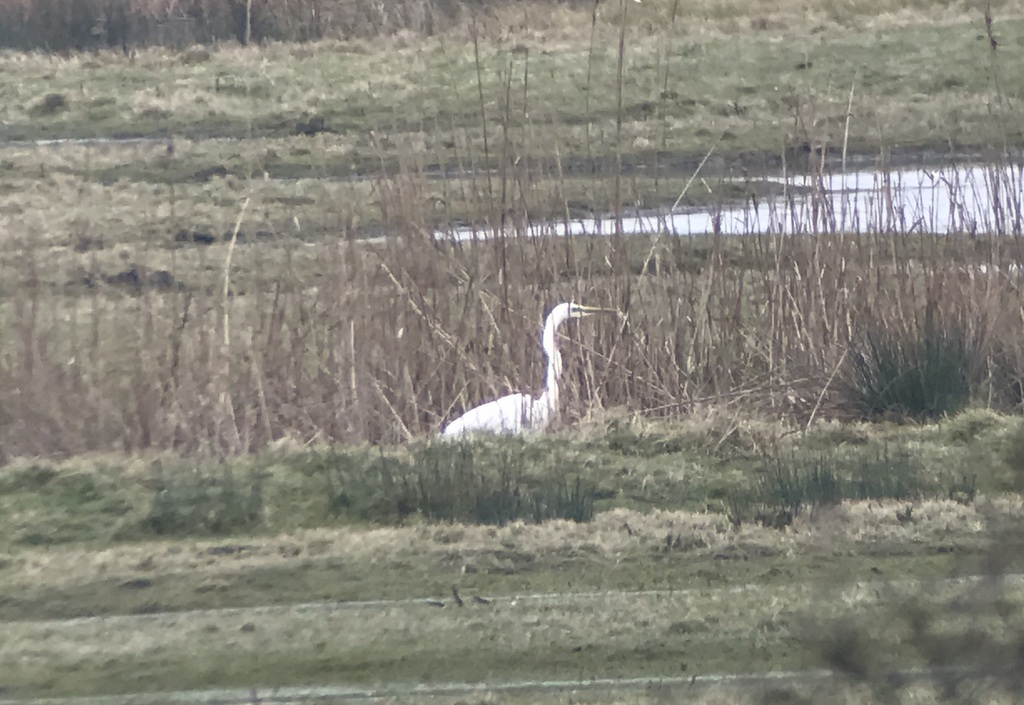
On the walk back, we stopped to watch a flock of tits which were dropping down to feed on the sandy bank by the edge of the track. It was slightly odd seeing several Long-tailed Tits, Coal Tits and even a Goldcrest hopping around on the ground here. Eventually they were flushed by someone walking past and disappeared back up into the trees.
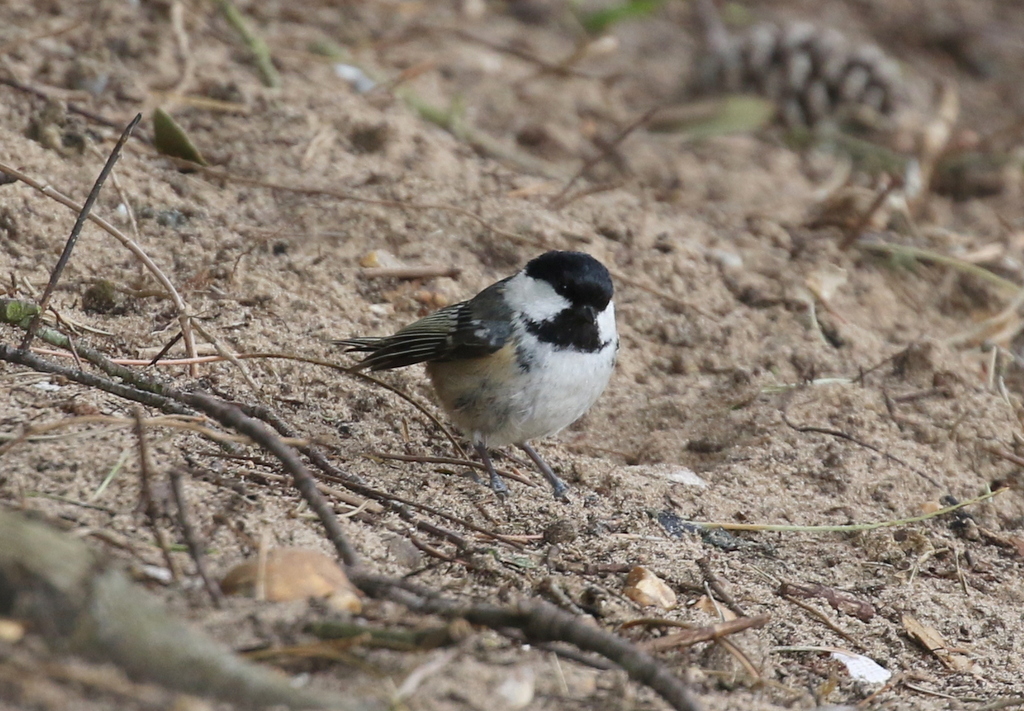
A quick scan of the grazing marshes from the other side failed to locate any White-fronted Geese either, although there were five more Pink-footed Geese this side. We made our way on to Titchwell for lunch. As we ate at one of the picnic tables by the visitor centre, a couple of Greenfinches came in to join the Chaffinches and Goldfinches on the feeders. We could hear Bramblings singing high in the trees here too.
After lunch, as we carried our picnic bags back to the car, we could hear several more Bramblings – more of a wheeze than a song really. We stopped and found them feeding on buds in the sallows alongside the path.
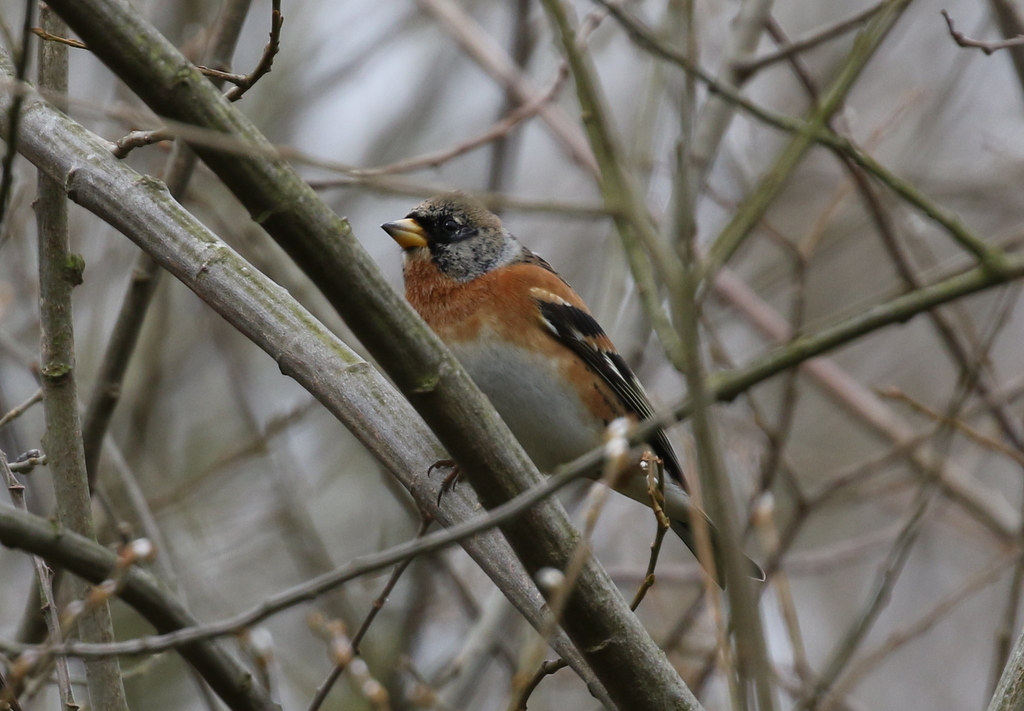
We made our way out onto the reserve to see what we could find next. There was no sign of a Water Rail in the ditches by the path, but we did find one on the edge of the reeds at the back of the Thornham grazing marsh ‘pool’. There were also a few Pied Wagtails and Linnets on here, but we couldn’t find anything else today. There were a few Tufted Duck and three Common Pochard, as well as a lone Gadwall, on the reedbed pool. A single Grey Plover was out on the Lavendar Marsh pool.
The Bearded Tits have been showing really well this week, around the small pools along the edge of the reedbed next to the path. It had clouded over and was rather cool now that the wind had picked up, so we wondered whether they would still be there today. It seemed very quiet as we walked up, but after waiting a couple of minutes we heard a Bearded Tit call and looked down to see a very smart male working its was between the reeds along one edge.
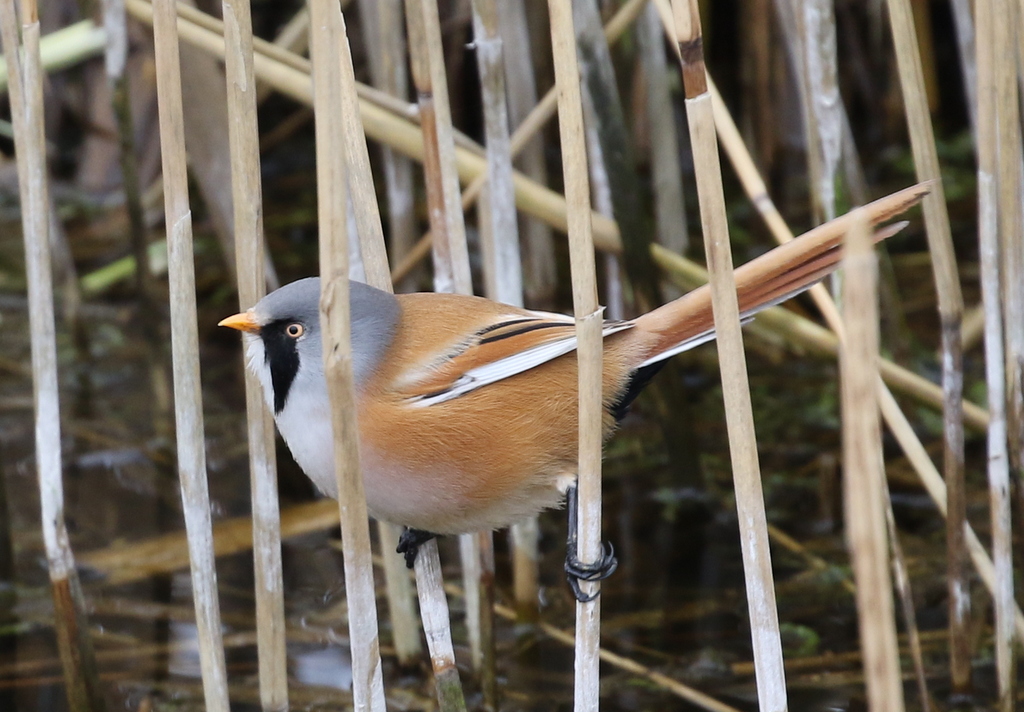
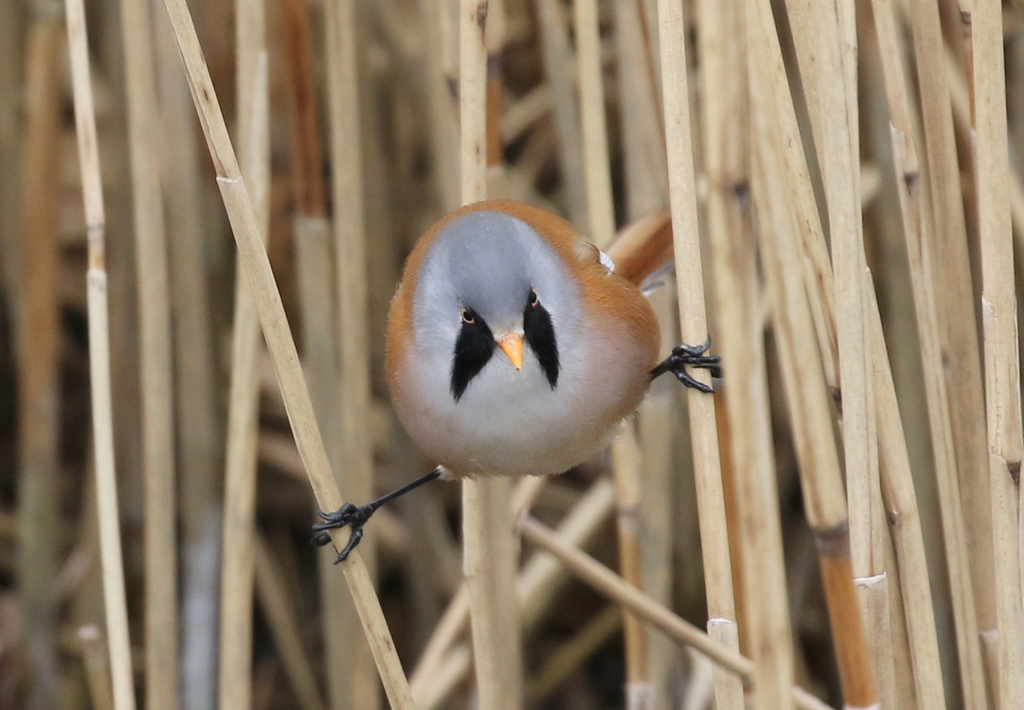
There were actually several Bearded Tits around the small pools here again this afternoon, although it was hard to say how many as they were constantly on the move and in and out of the reeds. We saw at least two smart males, admiring their powder blue-grey heads and black moustaches.
The water level on the freshmarsh is still very high at the moment, so we didn’t stop at Island Hide again. Given the chilly wind, we headed straight round to the shelter of Parrinder Hide. We took a quick detour just beyond the turn to the hide to admire a Knot which was feeding on the mud right by the path on the Volunteer Marsh.
As we were walking along the path which leads out to the hide, we spotted a couple of small waders on the muddy edge of one of the few islands which protrude above the water and a quick look through binoculars confirmed they were a pair of Little Ringed Plover. We could just make out their golden yellow eye rings.
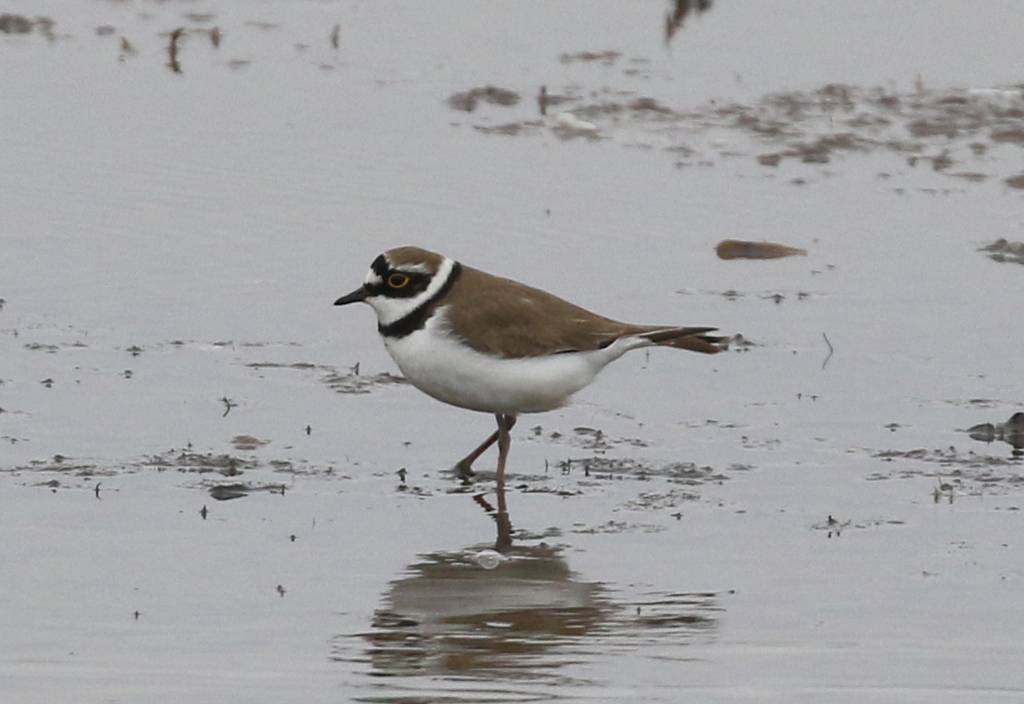
Little Ringed Plovers are summer visitors here, so it is always nice to see them return in the spring, although there is not much mud for them on the freshmarsh at the moment. We could just see them over the bank, but we had a better look out from the end of the hide.
There were a few other waders on here today. A small group of Black-tailed Godwits were asleep in the deeper water and a loose flock of Ruff were feeding nearby. A single female, a Reeve, was noticeably smaller next to the males, one of which sported a partly white head. There were a few Redshank with the Ruff too. A lone Knot dropped in with them and a small group of Turnstone flew in and landed on the pile of bricks which stood clear of the water.
As well as the usual Teal and a single Gadwall, three Red-crested Pochard eventually appeared from behind one of the islands in the middle and a smart pair of Pintail were hiding with the Mallard beyond the larger, fenced off island. A small flock of Brent Geese flew in for a bathe and a preen.
We had heard several Mediterranean Gulls and seen them flying past as we walked out along the path. We could see lots now, in amongst the Black-headed Gulls out on the fenced-off island. A pair or two of Mediterranean Gulls landed out in the water in front of the hide too, where we could get a really good look at them. They look particularly smart at the moment, with their jet black hoods and white eyelids.
Looking more closely through all the gulls, we noticed a smaller bird out on the island. It was a single Sandwich Tern. Through the scope we could see its yellow-tipped black bill and shaggy black crest. They are only now starting to return for the breeding season, and are not often on the freshmarsh, so this was a nice bonus today.
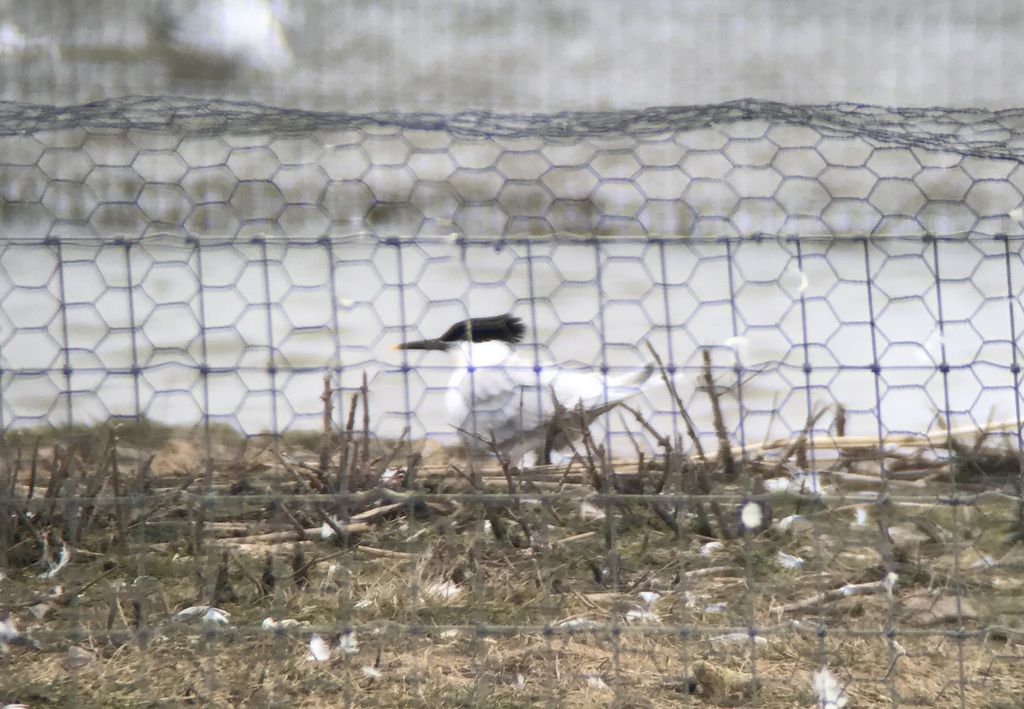
Looking out from the other side of Parrinder Hide, the Volunteer Marsh looked quite quiet. There were quite a few Shelduck out on the mud, and a Curlew either side of the hide, but not much else. We decided to make a dash out towards the beach. Back out on the main path, at the far end of Volunteer Marsh, an Avocet was feeding up to its belly in the deepest pool. There were more waders along the edge of the channel here – Black-tailed Godwits, Redshank and Curlew.
The Tidal Pools are full of water at the moment, so there is not much on here apart from a few Shelduck and Teal. However, while we were walking past, five Red-crested Pochard flew in. They couldn’t make up their minds whether they wanted to land on the water or not, almost touching down several times before flying up and round us again. Eventually, they decided not to and headed off back over towards the freshmarsh.

The tide was coming in fast out at the beach. The Knot were all flying off to roost as we walked out, but there were still a few waders out on the shore. As well as lots of Oystercatchers, we found a couple of Bar-tailed Godwits with them. Several Sanderling were running in and out of the waves.
As well as being windy, there was quite a bit of misty cloud now which meant we couldn’t see too far offshore. A quick scan revealed a Great Crested Grebe close inshore and a male Red-breasted Merganser which wasn’t easy to see in the swell. We decided to head back.

As we passed the Volunteer Marsh, the Knot was back close to the path so we stopped for another look. On our way to the visitor centre, we swung round via the Meadow Trail, but the bushes here were all very quiet now. On our way to the car park, a Redwing was hiding deep under a pile of branches beneath the sallows and it was very tricky even to see the leaves it was throwing up. A Chiffchaff was flitting around overhead.
When we got back to the car, it started to spit with rain. We didn’t mind now we had finished – it was time to head for home.
















